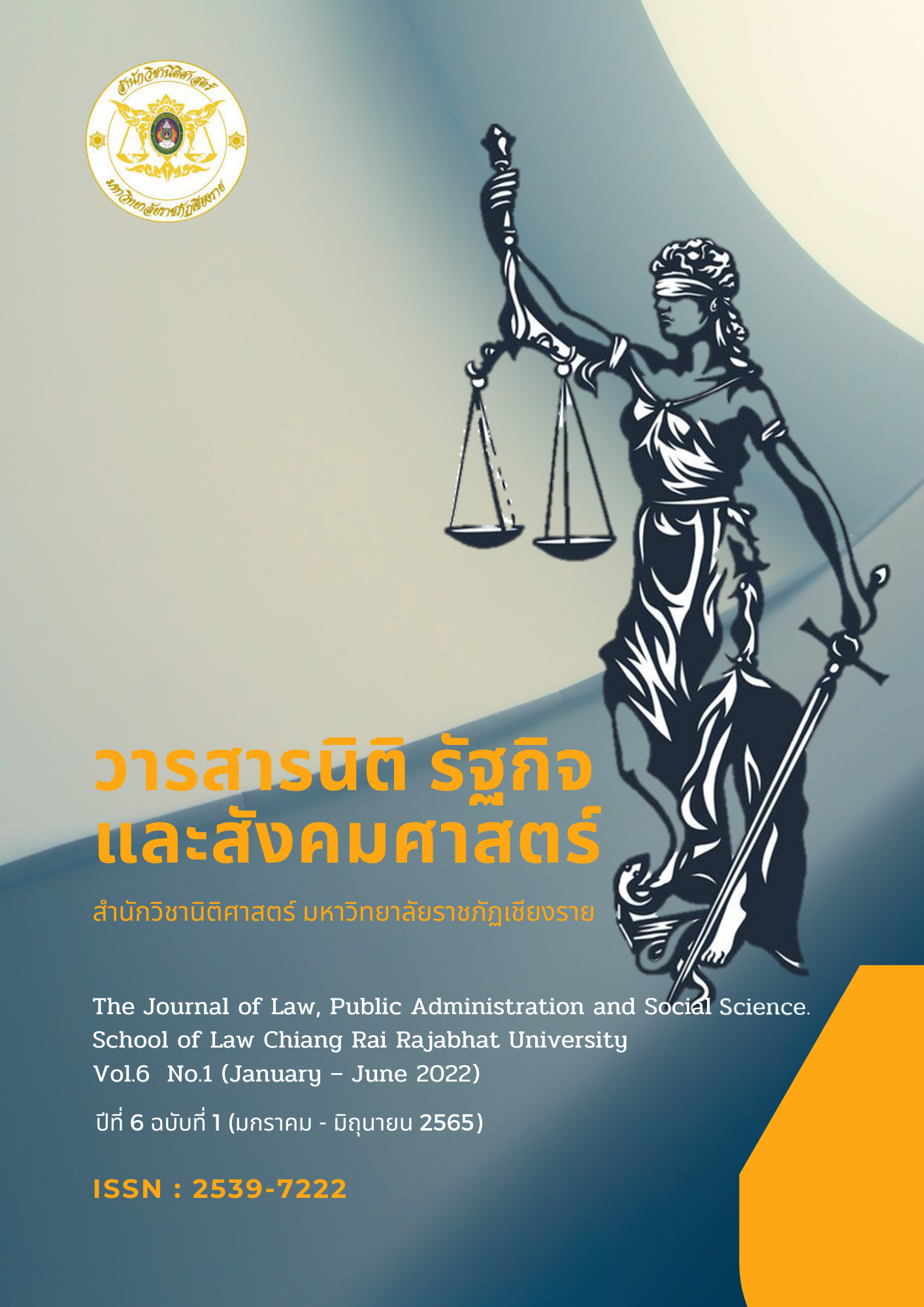Legal Measure for Air Pollution control in Thailand : Study the Effective Process Prevention, Control and Correction or Disposal of Particulate Matter Not More Than 2.5 Microns (PM2.5) in Foreign Countries
Main Article Content
Abstract
Nowadays, Thailand is faced with a problem of particulate pollutants that are 2.5 microns or smaller in size (PM 2.5) that cause by the dust form burning of agricultural waste and the forest fire in the north of Thailand And dust from transportation and construction in Bangkok. The problem of air pollution in Thailand are extensive and could become more seriously in the future. If there is no effective solution to the problem, It may cause damages on economic, Society and on the health of the people in the country. To find solutions to these problems, an international comparative legal study was made of measures to prevent, control, correct and remove PM 2.5 by relevant agencies as well as laws in the United States of America (USA) and Singapore, to provide problem-solving guidelines.
Results were that Thailand’s Enhancement and Conservation of the National Environmental Quality Act, B.E. 2535 (1992) contained insufficiently comprehensive legal measures to prevent, control, correct, and dispose of PM 2.5. These findings suggest that current legal measures in Thailand should be amended to manage PM 2.5 aerosol particle problems more efficiently.
Article Details
References
กองอนามัย กระทรวงสาธารณสุข. แนวทางการเฝ้าระวังพื้นที่เสี่ยงจากมลพิษทางอากาศกรณีหมอกควัน. นนทบุรี : โรงพิมพ์ชุมนุมสหกรณ์การเกษตรแห่งประเทศไทย จำกัด. 2558. 3.http://hia.anamai.moph.go.th/download/hia/manual/book/book 43.pdf. สืบค้นเมื่อ 20 กุมภาพันธ์ 2564.
เชียงใหม่นิวส์. “เปิดรับซื้อวันแรก ชาวเชียงใหม่ให้ความสนใจขายใบไม้กิโลละ 2 บาท.” 2564. https://www.chiangmainews.co.th/page/archives/1622750/. สืบค้นเมื่อ 2 พฤษภาคม 2564.
ธนาคารแห่งประเทศไทย. “ปัญหาหมอกควันภาคเหนือกับแนวคิด Sandbox CMU Model.” BOT พระสยามMagazine 43, ฉ.6 (2563): 11. https://www.bot.or.th/Thai/ BOTMagazine/Documents/PhraSiam0663 /BOTMAG06_63.pdf#page=7. สืบค้นเมื่อ 20 กุมภาพันธ์ 2564.
ปีดิเทพ อยู่ยืนยง. “ประวัติความเป็นมาและวิวัฒนาการของพระราชบัญญัติอากาศสะอาด 1956 ของสหราชอาณาจักร.”วารสารนิติ รัฐกิจ และสังคมศาสตร์ 4. ฉ.2 (กรกฏาคม 2563).
พระราชบัญญัติส่งเสริมและรักษาคุณภาพสิ่งแวดล้อมแห่งชาติ พ.ศ. 2535. ราชกิจจานุเบกษา ฉบับกฤษฎีกา เล่มที่ 109 ตอนที่ 37 (4 เมษายน 2535): 1.
พัชราพร ทิมวัฒน์. “ความร่วมมือในการจัดการปัญหามลพิษจากหมอกควันของประเทศ เพื่อนบ้านที่ข้ามแดนมาสู่ประเทศไทยภายใต้ข้อตกลงอาเซียน เรื่องมลพิษจากหมอกควันข้ามแดน.” วิทยานิพนธ์ปริญญามหาบัณฑิต คณะรัฐศาสตร์ มหาวิทยาลัย ธรรมศาสตร์, 2558.
พิทักษ์ ศศิสุวรรณ. สภาพปัญหาการบังคับใช้กฎหมายเพื่อยุติวิกฤติหมอกควันในจังหวัดเชียงราย. หนังสือประมวลบทความในการประชุมวิชาการนิติสังคมศาสตร์ระดับชาติ หัวข้อ “จินตนาการใหม่ ภูมิทัศน์นิติศาสตร์ไทย” วันที่ 20 พฤศจิกายน 2563 ณ โรงแรมฟูราม่า จังหวัดเชียงใหม่.
ศิริชนก วิริยเกื้อกูล. “มลพิษหมอกควันข้ามแดน.” https://library2.parliament.go.th/ ebook/content-issue/2559/hi2559-087.pdf. สืบค้นเมื่อ 25 เมษายน 2564.
สำนักจัดการคุณภาพอากาศและเสียง กรมควบคุมมลพิษ. “ระเบียบและข้อปฏิบัติในการควบคุมฝุ่นละอองจากการก่อสร้างประเภทต่างๆ.” http://infofile.pcd.go.th/air/ dust_control.pdf. สืบค้นเมื่อ 10 พฤศจิกายน 2563.
สำนักนโยบายเศรษฐกิจมหภาค สำนักงานเศรษฐกิจการคลัง. “รายงานประมาณการเศรษฐกิจไทยปี 2562 และ 2563.” 2562. http://www.fpo.go.th/main/getattachment/ Economic-report/Thailand-Economic-Projections/.pdf.aspx. สืบค้นเมื่อ 9 กุมภาพันธ์ 2564.
Thai PBS. “ "ฝุ่นพิษ" ทุบสถิติรอบ 4 ปี ค่าสูงลิ่ว 366 มคก.ต่อ ลบ.ม..” 2563. https://news. thaipbs.or.th/ content/298574. สืบค้นเมื่อ 24 เมษายน 2564.
Air Now. “Air Quality Index (AQI) Basics.” https://airnow.gov/index.cfm?action= aqibasics.aqi. accessed February 1, 2021.
Clean Air Act 1963.
Cynthia Gorney. “Decades ago, this pollution disaster exposed the perils of dirty Air.” National Geographic, 2020. https://www.nationalgeographic.com /history/2020/10/decades-ago-donora-smog-disaster-exposed-perils-dirty -air/. accessed February 15, 2021.
Ellen Hey. Advanced Introduction to International Environmental Law. Massachusetts: Edward Elgar Publishing Limited, 2016. 55-77.
Environmental Protection and Management Act.
Kristen Welker-Hood and others. “The Clean Air Act A Proven Tool for Healthy Air.” A report from Physicians for social responsibility, pdf, Physicians for Social Responsibility, 2011. https://www.psr.org/wp-content/uploads /2018/05/clean-air-act.pdf. accessed February 17, 2021.
Lorraine Boissoneault. “The Deadly Donora Smog of 1948 Spurred Environmental Protection—But Have We Forgotten the Lesson?.” Smithsonian magazine, 2018. https://www.smithsonianmag.com/history/deadly-donora-smog-1948-spurred-environmental-protection-have-we-forgotten-lesson-180970533/. accessed February 15, 2021.
National Environment Agency. “Air quality in Singapore.” https://www.nea.gov.sg/our-services/pollution-control/air-pollution/air-quality. Accessed February 17, 2021.
Rio Declaration.
The world air quality project. “Air quality historical data.” https://aqicn.org /city/Bangkok. accessed February 9, 2021.
United states Environmental Protection Agency. “The Plain English Guide to the Clean Air Act.” https://www.epa.gov/sites/production/files/2015-08/documents/peg.pdf. accessed February 15, 2021.
United states Environmental Protection Agency. “NAAQS Table.” https://www. epa.gov/criteria-air-pollutants/naaqs-table. accessed February 17, 2021.
World Health Organization. WHO Air quality guidelines for particulate matter, ozone, nitrogen dioxide and sulfur dioxide. Geneva : World Health Organization, 2006.


